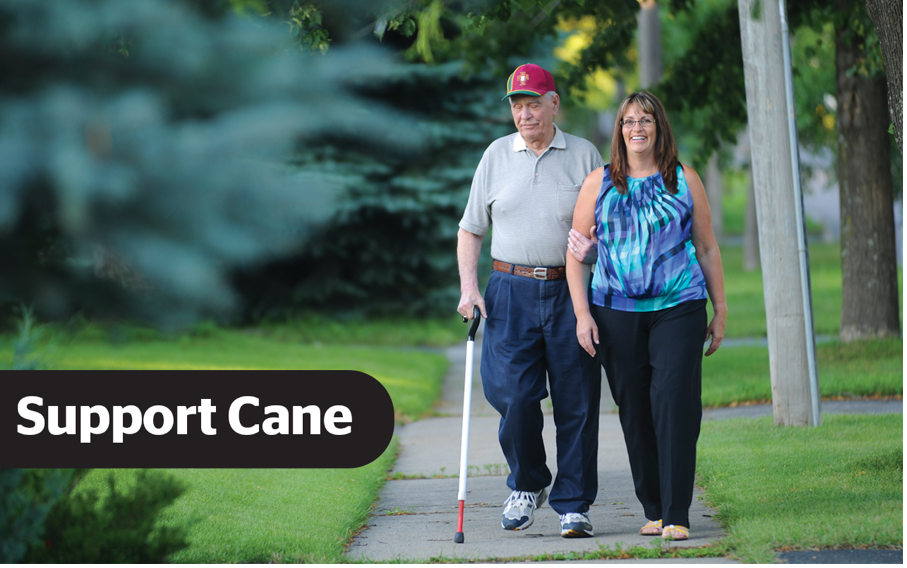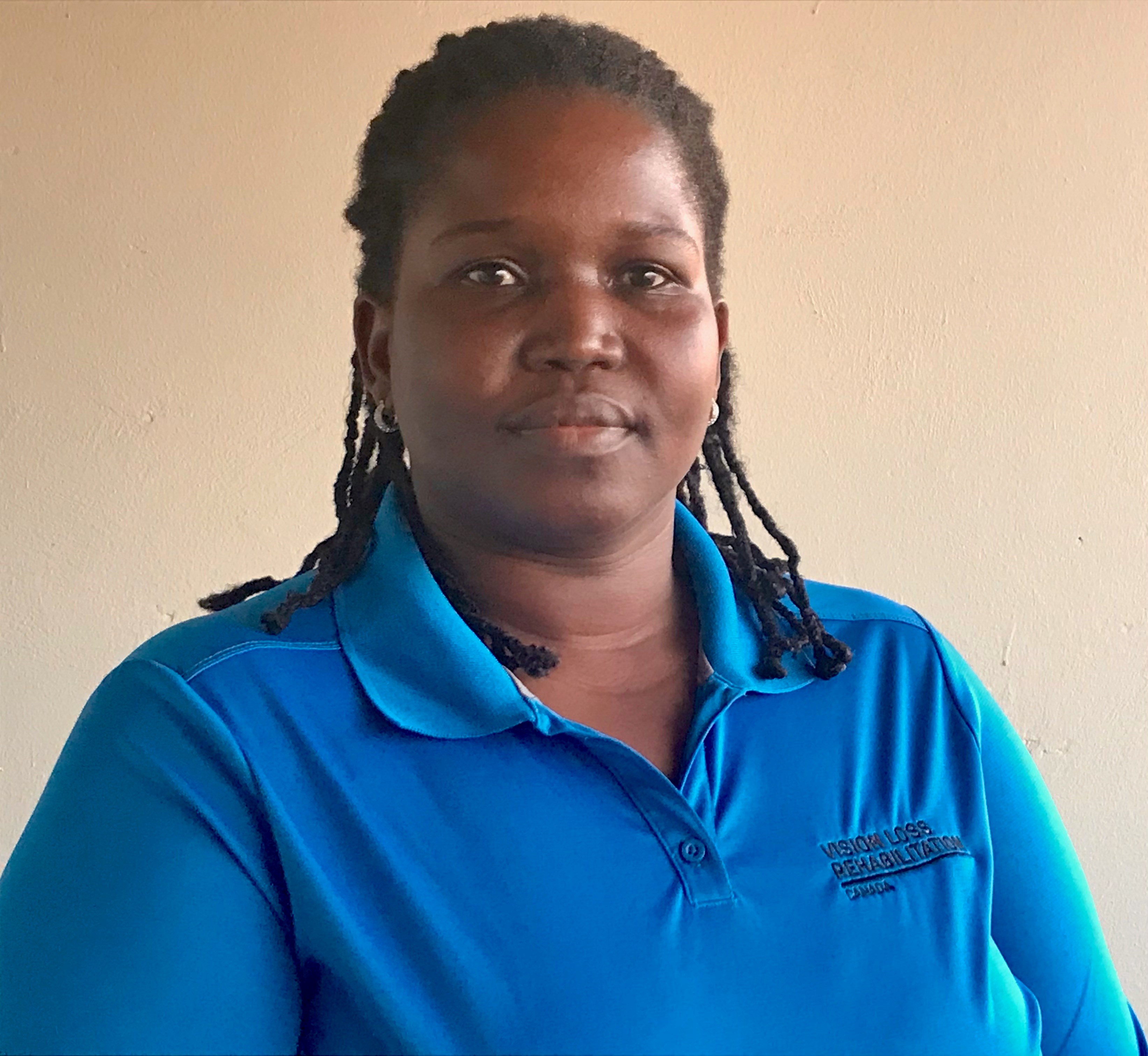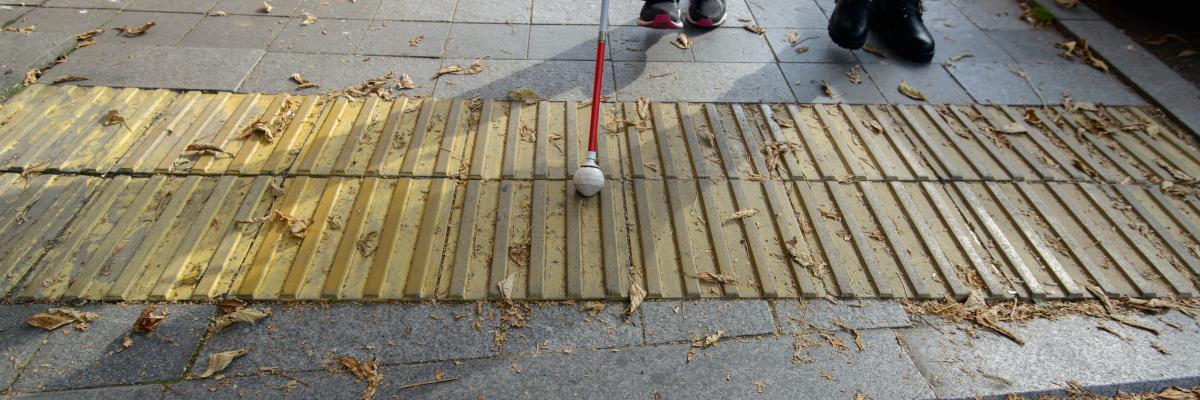What is a white cane?
A white cane is a navigation or identification aid for people living with sight loss. The use of a cane helps a person who is blind or partially sighted explore their surroundings, avoid obstacles and use tactile information to find their way, such as where to cross the road safely. It’s also an international symbol that lets others know that the user has sight loss.
Types of white canes used in Canada
Identification Canes
![A man wearing a suit entering into the lobby of an office building using an identification cane. The text "Identification Cane" are overlayed in white text on a black background.]](/sites/default/files/inline-images/ID%20CAne.png)
Identification (ID) canes are thin and straight canes. They are mostly white, but it can be customized, depending on personal preference. Usually, ID canes are held in front of the body to let others know you have sight loss. ID canes can be used by people who can navigate without a cane but wish to supplement or confirm visual information such as doorways and stairs. It lets others know that a person has sight loss.
Mobility Canes

Mobility canes are designed as navigation tools, and they are used to receive tactile feedback from the person’s environment. They are thicker and stronger than ID canes and extend at least from the floor to the sternum. Mobility canes can come with a variety of tip sizes and shapes that are in kept in contact with the ground. They identify what kind of texture and surface a person is walking on. They can detect objects and provide information about the environment to the user of what is ahead. The cane is usually red on the bottom section so it is more visible to the user and others.
Support Canes

Support canes are designed to offer physical support and stability, like a walker. The white colour makes others aware that it is being used by someone who is living with sight loss.
Learn to use a white cane
People who are blind or partially sighted receive specialized training from an Orientation and Mobility Specialist, who works with them to determine which navigation tool would best suit their needs.
Meet Irene Abiko – Certified Orientation and Mobility Specialist for Vision Loss Rehabilitation Canada
Irene is originally from Uganda where she certified in rehabilitation and worked with the sight loss community. After completing her Master’s in the United States she worked at the Columbia Lighthouse for the Blind in Washington DC. In 2019 she joined Vision Loss Rehabilitation Canada, after nearly 10 years in the field of post-vision loss rehabilitation.
Irene provided us with some insights into the work that she does as an Orientation and Mobility instructor, the barriers that she sees her clients face, and different ways the ways that she hopes we can overcome stigmas around the white cane in society.
Life as an O&M Instructor 
"I begin with an assessment since every person I see is operating at a different starting point. I then create their learning goals based on that assessment and what the person hopes to achieve.
When I hand over a cane to someone for the first time, I state the importance of cane etiquette, how to take care of the cane and use it responsibly. Once they have the basics, I focus on teaching them on how to detect an obstacle and navigate the environment around them.
I also determine which techniques they should be aware of, such as the pad technique; which is constant contact or tapping on each side, or the diagonal technique; where the user holds the cane in the diagonal position and just walks with it. I highlight that there are different techniques for different environments, such as how to detect the street corner or the sidewalk.
There are different types of cane that people can use depending on their situation. There are rigid or collapsible canes, but most people use collapsible because the person can fold it up and store it when they aren’t using it. You can also get lighter and heavier canes with different types of tips, depending on what a person needs. Some people who have some sight loss also require further physical support for walking and need to use a support cane. Vision Loss Canada does not train people on how to use these and a physiotherapist or a doctor can issue this type of cane.
Most of the barriers that my clients face when using the white cane come from the built environment. Neighbourhoods can have uneven surfaces, uncut bushes that grow over pedestrian areas, scooters thrown onto sidewalks, and other barriers that may not be identifiable by canes.
I would like to see more awareness raised about the white cane. Most times when someone sees a cane, they associate this with total blindness and a loss of independence. These attitudes can affect the person who is trying to use the cane, leading them to withdraw from using it. I want the public to know that someone holding a cane is a sign of their independence; they are ready for life and step into the unknown.
As well as raising awareness, as an O&M I will continue to advocate for my clients by carrying out environmental accessibility assessments with public institutions, city planners, and engineers so that they design public spaces that have greater accessibility for white cane users, and for everyone."
If you are blind or partially sighted and seeking orientation and mobility services, please visit Vision Loss Rehabilitation Canada.
